Field Crop Update, August 4, 2022
Erik Smith, Area Field Crop Specialist/Team Leader
Central New York Dairy and Field Crops
1. Field Observations
Madison and Chenango counties remain "abnormally dry", along with eastern Schoharie and Saratoga Counties, while the southern tip of Saratoga County is in a moderate drought:
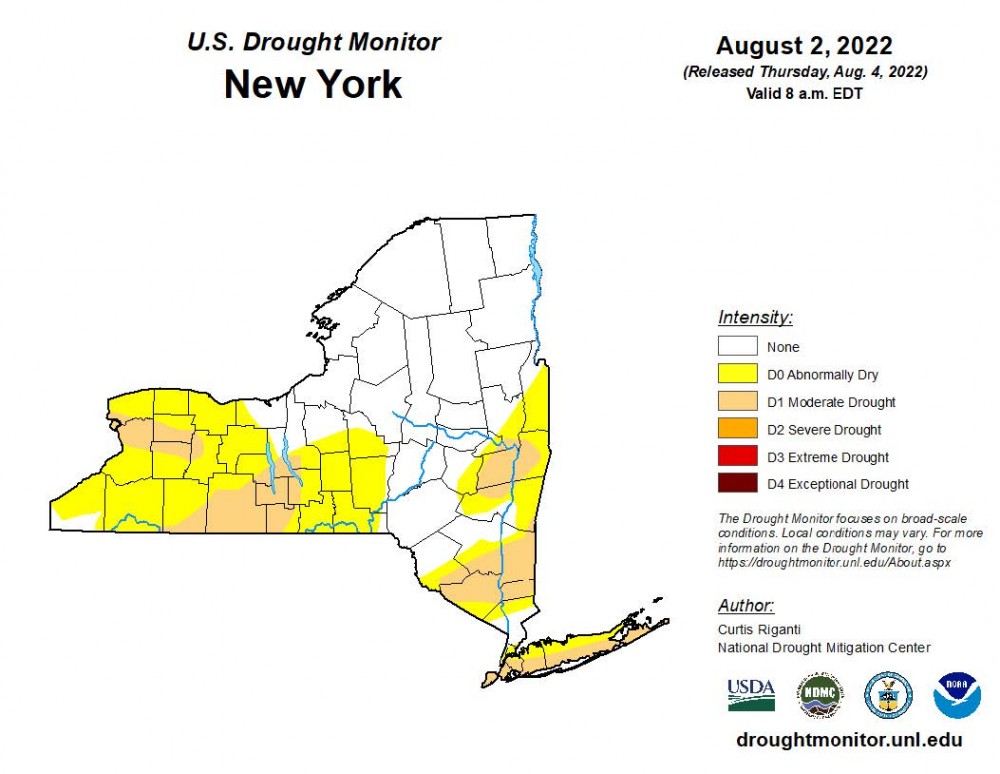
Early-planted corn and soybeans seem to be largely ok, but later plantings are really suffering. Rain is in the forecast all of next week, so hopefully that provides some respite. As we approach corn silage harvest, we will email some articles that help outline how to navigate harvest in a dry year.
3rd cutting alfalfa and second cutting of grass hay is suffering as well, so once again, consider a triticale winter cover crop that you can use for forage in spring.
2. Growing Degree Days as of Aug 2nd: See: Climate Smart Farming Growing Degree Day Calculator
Growing degree days (GDD) are calculated by taking the average daily temperature and subtracting the base temperature for development of a given organism ((High + Low)/2 - base temp = GDD). For corn silage, we are using base 50/86, as corn development starts at 50 degrees F and ceases above 86. Check your location and planting date:
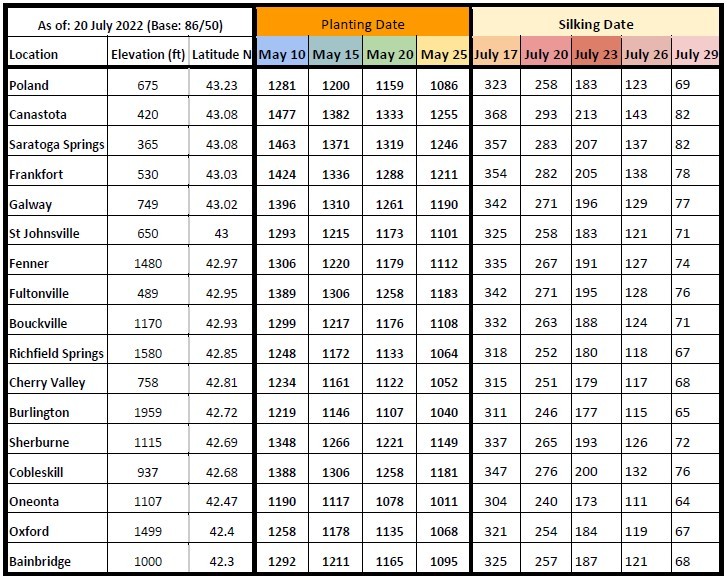
3. Pest and disease monitoring
Crop foliage continues to be largely clean in terms of insect pests and diseases. However, I've been checking every stand of knapweed I can find, and I managed to identify a single stand of true spotted knapweed in Montgomery county (a small stand in a ditch. So it's definitely out there, but I still haven't yet seen it in a hay field or pasture - I'm assuming it must be in some fields, somewhere). Once again, the main point of positively identifying knapweed species is that spotted knapweed (Centaurea stoebe) may be managed using biological control beetles, while these beetles are not effective at managing other knapweed species. Here are some pics I've taken recently, including the spotted knapweed. The bracts (papery scales beneath the flowers) are the identifying character:
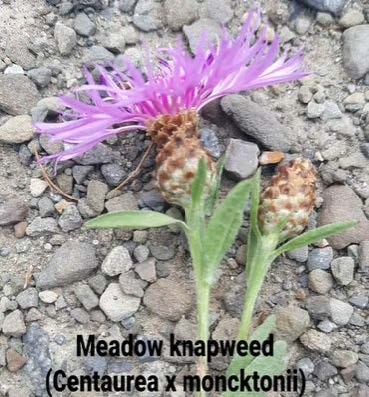
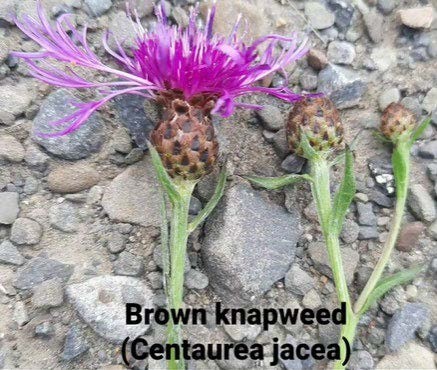
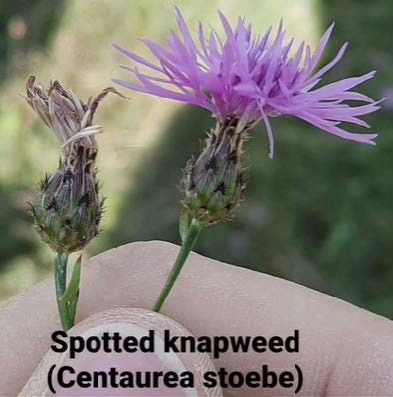
A. Western bean cutworm (WBC), true armyworm (TAW) and fall armyworm (FAW) in corn.
This week, insect numbers increased slightly, but remained relatively low. At tasseling, the window of risk for WBCW largely closes, and the cornfields where we saw the highest populations (still very low by damage-causing standards) have long-since tasseled and there are still no egg masses in sight. We'll continue monitoring for a few more weeks as we still want to track the life cycle of this relatively-new pest in NY so we can better predict its population dynamics in the future:
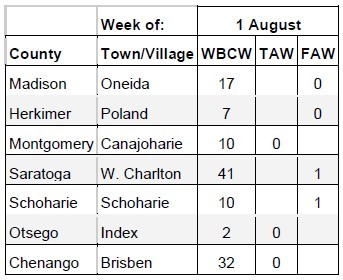
B. Potato leafhopper in alfalfa.
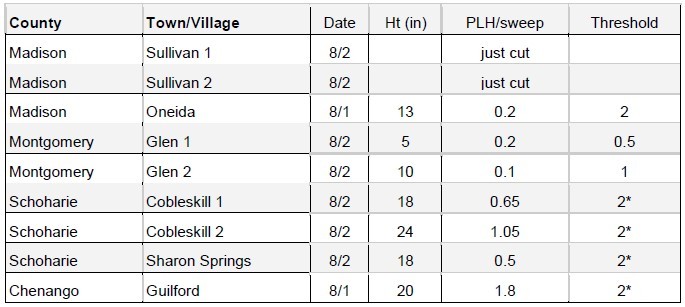
*No action needed within a week of harvest.
Field Crop Update, August 4, 2022 (pdf; 466KB)
Upcoming Events
IPM Strategies to Protect Corn and Soybean Seed in NYS
July 22, 2025
Cobleskill, NY
Free event. DEC Credits available
Clearing Hurdles to Improve Milk Quality Conference
July 22 - July 24, 2025
Rochester, NY
three day conference with short courses, seminars, and farm tours
Announcements
Sign Up for Our Weekly E-Newsletter
We send out a bi-weekly e-newsletter that has announcements, upcoming programs, and opportunities for you! Registration is quick, easy, and free. Click here to sign up today!Document and Share Storm Damage
Mother nature has really been difficult over the last few days. Significant damage has been seen throughout NYS. Please let us know what types of damage your farm may have sustained during this time. This could be in the form of property damage, lost power, milk dump due to lost power, loss of livestock, loss of stored feed or growing crops.Farms are encouraged to DOCUMENT AND SHARE any impacts the weather may have had on their home or business. This could include structure damage, crop loss, inventory loss due to power outages, damage to equipment or fencing, and more.
If your farm experienced any sort of damage, please reach out to any of the folks listed below (or all of them). The more impact information that is collected, the greater the likelihood of a disaster declaration which can bring vital emergency support and awareness. The CNYDLFC Team will continue to collect detail and submit to NYSDAM and the EDEN network.
Reporting Weather Related Impacts (For your home or farm business)
- First, ensure that all the people and animals on your farm are safe, and that there aren't any unsafe working conditions created because of the weather (check your structures!). If there's an emergency, call 911 - don't try to manage it all on your own.
- Second, document all negative weather impacts for your farm and their estimated financial cost. Take photos, make estimates, and put it all in a safe place.
- Reach out to your insurance providers - farm, vehicle, crop, etc. to initiate the claim process as needed.
- Then, share your farm's damage with any (or all) of the ag support agencies listed below. We all work together to collect storm damage information and funnel it up to Ag and Markets which can initiate a natural disaster declaration.
- Chenango: 607-334-5841
- Fulton/Montgomery: 518-853-2135
- Herkimer: 315-866-7920
- Madison: 315-684-3001
- Otsego: 607-547-2536
- Schoharie: 518-234-4303
- Saratoga: 518-885-8995
- Erik Smith: 315-219-7786
- Daniela Gonzalez: 315-749-3486
- Ashley McFarland- 315-604-2156
Your county USDA/FSA service center.
- Chenango: 607-334-3231
- Fulton/Montgomery: 518-853-4015
- Herkimer: 315-866-2520
- Madison:315-824-9076
- Otsego: 607-547-8131
- Schoharie: 518-295-8600
- Saratoga: 518-692-9940
Your county farm bureau manager
- Region 3: Bailey Coon: 518-937-0566
- Region 5: John Wagner: 315-761-9770
- Region 6: Natally Batiston: 518-937-0269
- Region 7: Todd Heyn: 518-431-9338
Please let us know how we can help you.
Cash Rent and Custom Harvest Survey
To date, there is limited information available about rental rates and fees for crop harvesting. Farms can use this valuable information for their farm business planning to help improve decision making and profitability.Farmers Can Join MeatSuite For Free!
MeatSuite.com is a free resource provided by Cornell University where NY meat farmers can create a farm profile and list their bulk (wholes, halves, quarters) and bundled (i.e. Grilling Bundle) meat products.Why should farmers join?
1. It's free and easy!
2. Connect with more local customers. In the past year the MeatSuite.com farm directory had 8,300 visits from New York consumers. Farm profiles get as many as 25 views per month from potential local customers. We also spotlight MeatSuite farms on social media and bring attention and purchases to farms through highlights and giveaways.
How do I join?
Farmers can visit https://www.meatsuite.com/farmers/ to create a free farm profile. You must list at least one product for your farm's profile to go live. You'll also have access to Cornell's free Meat Price Calculator, a helpful tool for pricing your meat to make a profit.
While you're on MeatSuite, check out the "Creating Consumer-Friendly Bulk Meats" publication on the log-in page. It has tips on how to create bulk meat products that are easier for first-time buyers to say "yes" to.
If you have any questions as you create your farm profile or products, we're here to help! Please email Matt LeRoux at mnl28@cornell.edu.




